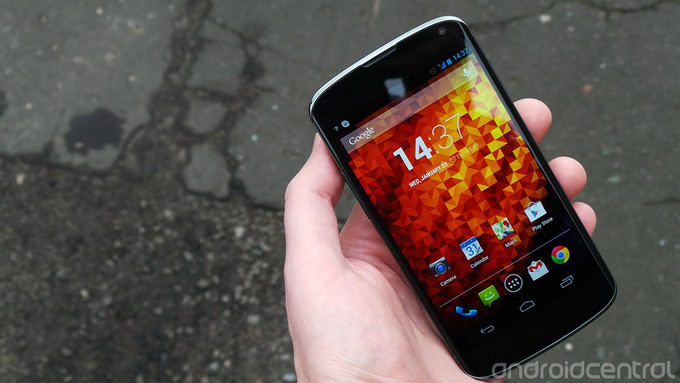Two months with Nexus 4
- Transfer
Preface from the translator
I believe that 80% of all phone reviews are complete slag; and they all look the same: with a hundred photos of the phone and screenshots of the system, analysis of all spherical characteristics and the final phrase like “N is a great phone for everyday use with a fast processor, but a fly in the ointment is a short battery life of the phone under a jet stream: only 2 seconds . Therefore, our rating is 7/10. ” But it seems to me that a real phone review is how it behaves in real life, and not a laboratory measurement of characteristics. It is a pity that such conclusions can be made only after months of use. This article from the Android Central website , dedicated to the Nexus 4, is intended to partially compensate for the lack of such experience . So, let's go :
A little over two months have passed since the Nexus 4 first appeared on Google Play. We all know very well that they sold it out extremely quickly (or, if you like it more, Google managed to deliver the devices even worse than last times). So, we can say that those who have been walking with him for 9 or 10 weeks are in the extreme minority ( article of January 23, 2013. Hereinafter in italics - approx. Transl. ).
Given this, we thought that we would return to the experience of using it two months later and look at how the flagship will show itself in everyday life. If you recently bought Nexus 4 or are still waiting for shipment, you can find out right now what awaits you in the future.
Under the cut - how Nexus 4 worked for 70 days in the hands of the editor of Android Central.
The rear window will be scratched
My Nexus 4 has been in my hands every day since mid-November, including a week of everyday use at CES 2013 in Las Vegas. He was falling. Just once. On the carpet. Nothing more happened to him.
For two months of ordinary use, he collected his share of scratches, and most of them accumulated on the rear window. Should he find himself without a case, the back panel will scratch very soon, even if you are very thrifty. In my case, the upper part of the rear window was strewn with the finest scratches, just like the back of the used iPod Classic. Fortunately, the dark shade of glass and the sparkling pattern make these scratches almost invisible most of the time. But they are, and you are well aware of this. Worse, some of them are dangerously close to the camera lens, and this is already a problem.
So far, I have not yet broken the back window of the phone, but the forum has a theme of the lucky ones who still managed to do this (photos are attached).

The only place where at least something else is scratched (but only slightly) is the upper part of the silver frame around the front panel; it is strange that the lower part now looks like new. All this is clearly visible in the photo below, but it is worth noting once again that such things are much more difficult to see. In any case, here is the result of the work of LG designers - a sparkling phone is very easy to scratch.
Although it will be difficult for you to find a phone that after a couple of months would not have collected the signs of operation, so the Nexus 4, although easily scratched, is no worse than any other. For example, the Galaxy S3, which I used about the same, collected several scratches on the back cover. However, in his case, all this was offset by its easy interchangeability. Also note that any shiny thing will collect scratches much faster than matte, such as the HTC One X with a polycarbonate case.
At the forum, the majority of respondents answeredthat they wear a Nexus 4 with covers or bumpers to avoid such troubles. Someone, however, likes to take risks. A palitsyn user writes: “I have a bumper and a case, but I stopped wearing them because I like the phone the way it is. If it breaks, it means it breaks. I want to enjoy my phone. ”

8 gigabytes of memory is almost enough
After I told you not to buy the 8-gigabyte version of Nexus 4, I went and bought the Nexus 4 8Gb. On a crazy day when sales started, I had only the choice between an 8-gigabyte nexus and no nexus, and I made the only possible decision for me - to order a younger model with less memory. But in the conditions of freedom of choice, I would still recommend paying an extra fifty dollars for double the amount of memory for the same reasons that I indicated in the original article ( the original link to the article is not given here, but I allow myself to agree a priori with the author : after all, 16 gigabytes can always fit more data if something happens ).
But since I eke out my miserable existence with Nexus 4 8Gb, limiting to 5.67Gb has not become such a big problem. Conventional Android applications do not require so much space, and since I had unlimited Internet access, listening to music through Google Play Music is more preferable to me than popping up your phone with mp3 files in the old fashioned way.
Most of the time, eight gigs will be enough for you (and we have heard from many manufacturers that the results of their surveys also confirm this). There are only a few cases where the low memory capacity of the Nexus 4 becomes a problem. The first is games. High-end games require a gigabyte of free space and more. Need for Speed: Most Wanted, for example, takes up two gigabytes. On 8Gb, this is more than a third of all the space available to you, so you should follow it if you are a game lover.
The second is any media consumption that requires files on the device. If you have a long flight (say, to the other end of the world to some cool exhibition) or you go somewhere where free data transfer is not so good (say, at some cool exhibition to the other end of the world), using files from the cloud is no longer a panacea. This means that you have to preload the phone with various data. And filling 5.67 gigabytes is much easier than you think, especially when applications with downloads should fit into the same framework.
The community is of the opinion that eight gigabytes is still a little missing, but sixteen more than. Badbrad17 user says about his 16Gb model: “I have all the applications I need, plus a bunch of photos and videos, and I still have 9 free gigabytes. And this is with 1.3 gigabytes of backups. Eight gigabytes is definitely not enough, but 16 is enough for most people. ”

Android 4.2 is a little weird but nice
Two months have passed since the start of sales, and Nexus 4 is one of only two phones that officially use Android 4.2 Jelly Bean with a “bare” shell, which remains the fastest, cleanest and most beautiful Android user interface among all devices. And Android 4.2, in turn, brings several important additions to the stock UI (I, on the contrary, are somewhat annoyed by the craving of Android developers to constantly improve, rearrange, and decorate something in their system. Once you get used to a certain type, for example, a drop-down panel, as in the next update it will be redone. It resembles a series of Ubuntu updates when one of the few noticeable changes was the replacement of the horizontal volume slider with a vertical one, and then, with the next update, back. It is noteworthy that iOS does not suffer from such alterations, and I consider this a sign of quality and distant UI planning ).
The only thing that did not make me so happy was the new lock screen, which now supports special widgets. Something in it seems to me whipped up, and after two months of use, it still remains one of the system's weakest points in terms of design. Nevertheless, I’m already used to it, and now it seems quite natural — and quick — to extend my finger from the center of the screen to unlock, or to grab the right edge of the screen to turn on the camera.
I was not tempted to try to install several different widgets for the lock screen. My argument for this, as before, is that such things make the very idea of a lock screen meaningless.
Stuffing the device - with a lot for the future, with one exception
In general, the Nexus 4 is an advanced smartphone, just like in November. There is still no processor that would surpass Qualcomm's Snapdragon S4 Pro, and in combination with timely updates from Google, we can say that the coming year of using the phone will definitely not disappoint you. I'm not going to complain that the Nexus 4 is missing some garbage like a 1080p screen like Droid DNA ( we have HTC J Butterfly ). Maybe we will return to this issue in the future, but the difference between 720p and 1080p is not so significant to seriously worry about it.
But once again, the camera becomes the Achilles heel of the Nexus 4. In November, I called the Nexus 4 camera “pretty good” and still think so. There is a whole topic on the forumfull of great shots taken by those who agree with me. But the production of cameras for telephones is far from the area where the industry stands still, and this year we have already seen cameras that can seriously move the Nexus 4 (for example, Sony Xperia Z ). So his camera cannot be compared with what we will see in 2013, and this is worth considering if you are still choosing a phone.


With LTE, everything is still incomprehensible
Officially, Nexus 4 does not support LTE, and the fastest way to transfer data remains HSPA +. The unofficial picture is still the same vague. Owners of Nexus 4 in the US and Canada were pleasantly surprised shortly after the start of sales, learning that the phone hid LTE support. It uses exactly those frequencies that T-Mobile will soon use, so subscribers of this network are looking forward to an update that would open official support for LTE. However, the necessary papers have not yet passed the Federal Communications Commission, so we will have to wait and see what will happen in the future.
No matter what happens with LTE support on the current Nexus 4, it seems to me that we can still see the new Nexus 4 with LTE support from other operators in different territories. The US market may turn out to be rather unfriendly to unlocked LTE devices, but in Europe everything is basically standardized around the frequencies of 800, 1800 and 2600 MHz, and now it is possible to buy unlocked European phones with LTE.
Do not forget about Sprint, which alone pulled the Nexus S 4G and Galaxy Nexus . Today, Nexus 4 with unlocked LTE could become a real super-phone for this operator, which has recently been feeling not quite confident.

Nexus 4 is still not possible to buy on the Play Store
( already quite possible )Either because of supply problems , or because of underestimated demand , the Google Play Store effectively blocked the sales of Nexus 4. Google is still dealing with this problem, but two months of spoiled sales have already passed phone.
LG says things will get better by mid-February, but if you've been waiting for months for the Nexus 4 to come out, what is it worth a couple more weeks to wait for a chance to grab the Xperia Z? Or what will HTC introduce to us at Mobile World Congress? Phone geeks are pretty fickle.
Total
Not surprisingly, after two months, the Nexus 4 is still a great phone. Other devices will be able to overshadow it only in a few months - this is the order of things in the mobile industry. If you buy it today, it will not be brand new forever. In the end, any phone can be broken.
We did not select the Nexus 4 as the 2012 phone for the reasons that we have already indicated in another article. But after two months of active use of Nexus, which came out from under the wing of LG, would I advise you to it? Definitely.
